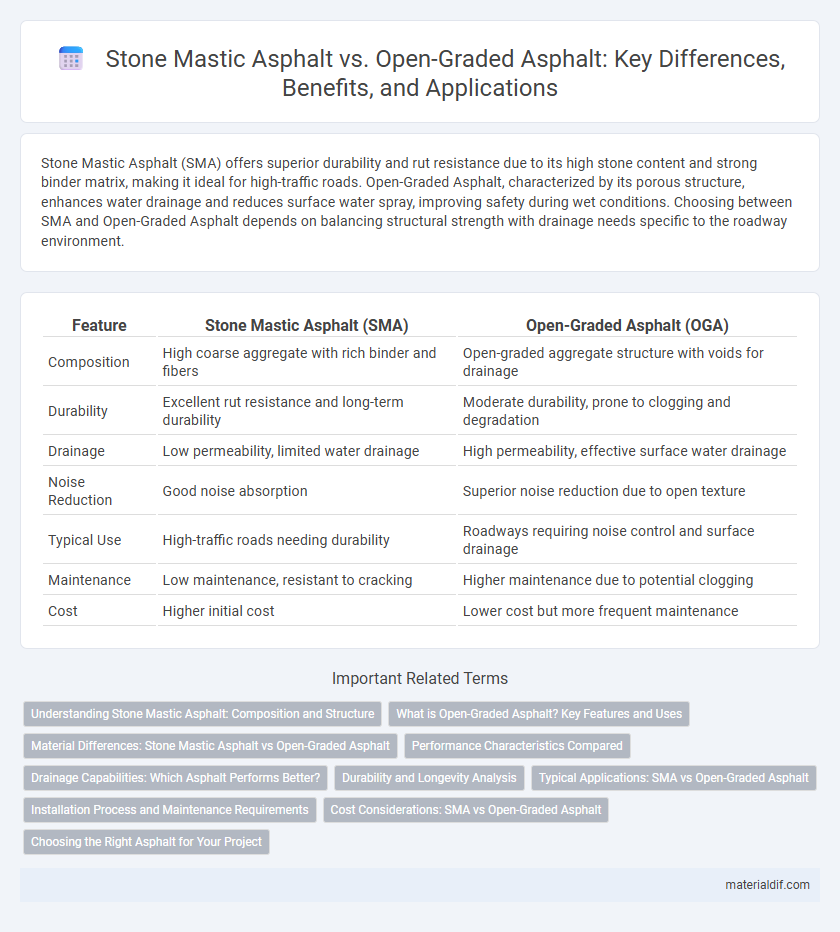Stone Mastic Asphalt (SMA) offers superior durability and rut resistance due to its high stone content and strong binder matrix, making it ideal for high-traffic roads. Open-Graded Asphalt, characterized by its porous structure, enhances water drainage and reduces surface water spray, improving safety during wet conditions. Choosing between SMA and Open-Graded Asphalt depends on balancing structural strength with drainage needs specific to the roadway environment.
Table of Comparison
| Feature | Stone Mastic Asphalt (SMA) | Open-Graded Asphalt (OGA) |
|---|---|---|
| Composition | High coarse aggregate with rich binder and fibers | Open-graded aggregate structure with voids for drainage |
| Durability | Excellent rut resistance and long-term durability | Moderate durability, prone to clogging and degradation |
| Drainage | Low permeability, limited water drainage | High permeability, effective surface water drainage |
| Noise Reduction | Good noise absorption | Superior noise reduction due to open texture |
| Typical Use | High-traffic roads needing durability | Roadways requiring noise control and surface drainage |
| Maintenance | Low maintenance, resistant to cracking | Higher maintenance due to potential clogging |
| Cost | Higher initial cost | Lower cost but more frequent maintenance |
Understanding Stone Mastic Asphalt: Composition and Structure
Stone Mastic Asphalt (SMA) features a coarse aggregate skeleton that provides high load-bearing capacity and durability, surrounded by a rich mortar of bitumen, filler, and fibers to enhance cohesion and reduce deformation. Its composition includes 70-80% coarse aggregates, 8-12% filler, and modified bitumen binders, creating a dense and gap-graded structure that resists rutting and skid. The interlocking texture of SMA ensures excellent resistance to heavy traffic loads and environmental stress, distinguishing it from the more permeable and less dense Open-Graded Asphalt.
What is Open-Graded Asphalt? Key Features and Uses
Open-Graded Asphalt is a porous pavement material characterized by a high percentage of interconnected air voids, typically ranging from 18% to 25%, which allows water to drain through the surface, reducing hydroplaning and improving skid resistance. Its key features include enhanced permeability, noise reduction, and superior drainage, making it ideal for use in highway shoulders, airport runways, and parking lots where water management and safety are critical. Open-Graded Asphalt is commonly employed in regions with high rainfall or where stormwater runoff control is a major concern, providing both environmental benefits and improved road performance.
Material Differences: Stone Mastic Asphalt vs Open-Graded Asphalt
Stone Mastic Asphalt (SMA) features a high content of coarse aggregates bound by a mastic composed of bitumen and filler, providing exceptional durability and rut resistance. In contrast, Open-Graded Asphalt (OGA) utilizes a higher percentage of air voids with a more open aggregate structure, enhancing permeability and drainage but reducing load-bearing capacity. The material composition of SMA emphasizes strength and longevity, whereas OGA prioritizes water runoff management and skid resistance.
Performance Characteristics Compared
Stone Mastic Asphalt (SMA) offers exceptional rut resistance and durability due to its high coarse aggregate content and rich mortar binder, making it ideal for heavy traffic areas. Open-Graded Asphalt (OGA) provides superior drainage and skid resistance by allowing water to drain through its porous structure, reducing hydroplaning risks. While SMA excels in load-bearing performance and longevity, OGA is preferred in environments requiring enhanced surface water management and noise reduction.
Drainage Capabilities: Which Asphalt Performs Better?
Stone Mastic Asphalt (SMA) offers superior structural integrity and durability but has lower permeability compared to Open-Graded Asphalt (OGA), which is specifically designed for enhanced drainage due to its high void content. OGA's porous structure efficiently allows water to pass through, reducing surface water accumulation and improving skid resistance in wet conditions. For applications prioritizing drainage capabilities, Open-Graded Asphalt outperforms Stone Mastic Asphalt by minimizing hydroplaning risks and promoting rapid water evacuation.
Durability and Longevity Analysis
Stone Mastic Asphalt (SMA) offers superior durability and longevity due to its dense, gap-graded aggregate structure and high binder content, which enhances resistance to rutting, fatigue, and weathering. Open-Graded Asphalt (OGA) features a porous design that promotes water drainage but compromises structural strength, leading to faster deterioration under heavy traffic and environmental stress. For infrastructure projects prioritizing lifespan and load-bearing capacity, SMA demonstrates a more robust performance profile compared to OGA.
Typical Applications: SMA vs Open-Graded Asphalt
Stone Mastic Asphalt (SMA) is typically used for high-traffic roadways and highways due to its excellent rut resistance and durability under heavy loads. Open-Graded Asphalt is commonly applied in surface treatments and drainage layers, providing superior water permeability and skid resistance. SMA suits structural pavement layers while Open-Graded Asphalt enhances surface safety and stormwater management.
Installation Process and Maintenance Requirements
Stone Mastic Asphalt (SMA) requires a precise installation process involving a well-designed aggregate skeleton and a rich mortar binder to ensure durability and rut resistance, typically necessitating high compaction efforts. Open-Graded Asphalt (OGA) installation focuses on maximizing porosity to enhance drainage, involving careful selection of coarse aggregate and controlled compaction to maintain void structure. SMA demands less frequent maintenance due to its dense structure, whereas OGA requires regular inspection and cleaning to prevent clogging and ensure effective water drainage.
Cost Considerations: SMA vs Open-Graded Asphalt
Stone Mastic Asphalt (SMA) generally incurs higher initial costs due to its dense grading, increased binder content, and specialized production requirements compared to Open-Graded Asphalt (OGA). While OGA offers reduced material and construction expenses, its lower durability may lead to higher long-term maintenance costs. Evaluating life-cycle costs highlights SMA's superior performance benefits despite a greater upfront investment, making it cost-effective for high-traffic or heavy-load applications.
Choosing the Right Asphalt for Your Project
Stone Mastic Asphalt (SMA) offers superior durability and rut resistance, making it ideal for high-traffic roads and heavy load applications, while Open-Graded Asphalt provides excellent drainage and skid resistance, suitable for areas prone to water accumulation. Selecting the right asphalt depends on project requirements such as traffic volume, environmental conditions, and desired surface texture. Understanding these key performance differences ensures optimal pavement longevity and safety tailored to specific infrastructure needs.
Stone Mastic Asphalt vs Open-Graded Asphalt Infographic

 materialdif.com
materialdif.com